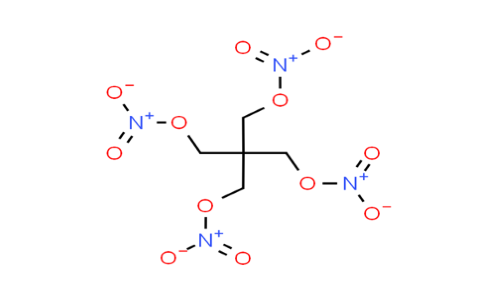PETN (pentaerythritol tetranitrate), also known as PENT, PENTA, TEN, corpent, or penthrite, is an explosive material. It is the nitrate ester of pentaerythritol and is structurally very similar to nitroglycerin. Penta refers to the five carbon atoms of the neopentane skeleton. First synthesised in the late 19th century, PETN's unique properties have since established it as a key component in many manufacturing processes. Apart from its explosive applications, PETN has found a place in the medical field as well. In controlled, minuscule doses, it is used as a vasodilator to treat certain heart conditions, showcasing its diverse utility. PETN stands out for its impressive energy output and adaptability, but it also requires careful management to harness its full potential safely and effectively. Whether powering large-scale industrial projects or aiding in medical treatments, PETN remains a critical material with a significant impact across various sectors.

| CAS Number: | 78-11-5 |
| UN Number: | 150 |
| Hazard Class: | 1.1D |
| Packing Group: |
Physical properties of Pentaerythritol tetranitrate (PETN) - water wet (15-20%)
What is the CAS Number of PETN?
The CAS number of PETN is 78-11-5.
What is the UN Number of PETN?
The UN number of PETN is 150.
What is the Hazard Class of PETN?
The hazard class of PETN is 1.1D.
What is the Packing Group of PETN?
PETN does not have a packing group.
Safety Information for Pentaerythritol tetranitrate (PETN)
You can find comprehensive safety details for PETN (Pentaerythritol Tetranitrate) in our MSDS (Material Safety Data Sheet.) This document includes important information on accidental spills, first aid, fire response, handling and storage guidelines, personal protective measures, and more. Make sure to familiarise yourself with the potential hazards associated with handling this material.
FAQs
Our shipping solutions are tailored to meet your specific PETN needs, taking into account quantity and destination. We provide personalised quotes to ensure smooth supply chain and logistical processes.
Simply share your specific requirements with our sales team, and we will ensure they are met.
Yes. No matter your location – Europe, Asia, or beyond – we possess the expertise to get your chemicals exactly where you need them. If you’re looking for Pentaerythritol Tetranitrate delivery and want to talk it through, contact us today.
PETN is a highly explosive compound with several associated hazards. Understanding these hazards is crucial for safe handling and use. Below are the key dangers and safety precautions associated with PETN:
Danger indications
PETN is an explosive with a mass explosion hazard, meaning it can cause a widespread blast affecting the entire surrounding area.
Caution advice
Keep PETN away from heat, hot surfaces, sparks, open flames, and other sources of ignition. Do not smoke near PETN.
Maintain PETN with greater than 25% humidity to reduce the risk of detonation.
Store PETN only in its original packaging to prevent contamination or accidental detonation.
Ensure all containers and receiving equipment are properly earthed and linked to prevent static discharge.
Avoid activities that might cause abrasion, shock, or friction.
Use appropriate personal protective equipment (PPE), including gloves, protective clothing, and eye/face protection.
Additional hazards
PETN can explode when exposed to intense heat, fire, shock, severe friction, or electrostatic discharge in a dry condition.
In case of a fire, it is advised not to extinguish the flames but to evacuate personnel immediately as the substance can explode.
First-aid measures
Inhalation: Move the person to fresh air and keep them at rest. If breathing is impaired, provide artificial respiration and seek immediate medical advice.
Skin contact: Wash the affected area with water and soap for at least 15 minutes, remove contaminated clothing, and seek medical advice.
Eye contact: Rinse the eyes with plenty of water for 15 minutes, keeping the eyelids open, and seek medical attention.
Ingestion: Rinse the mouth with water. Do not induce vomiting. If the person is conscious, seek medical care immediately.
Fire-Fighting Measures
Do not attempt to extinguish PETN fires. Instead, evacuate the area and let the fire burn out. If dealing with a vehicle or tyre fire, use plenty of water to flood the fire. If water is unavailable, use CO2, dry chemical powder, or mud.
Accidental release measures
Evacuate the area and maintain a safe distance of at least 500 metres. Use breathing apparatus if exposed to dust, fumes, or aerosols. Avoid sources of heat, flames, and electrostatic discharge. Do not smoke.
Contain spills using suitable containers such as cardboard or plastic, ensuring all handling equipment is grounded. Use appropriate PPE during cleanup.
Handling and storage
Use proper protective equipment and protect containers from physical damage. Avoid contact with incompatible materials and prevent electrostatic discharge build-up.
Store PETN in its original container, in a dry, well-ventilated place away from heat, open flames, and ignition sources. The substance should be kept wet to reduce risk.
Understanding these hazards and following the recommended safety precautions is essential for anyone handling or working with PETN to prevent accidents and ensure a safe environment.
IF YOU WANT TO LEARN MORE ABOUT HOW EAST HARBOUR GROUP LTD CAN HELP YOUR BUSINESS, GET IN TOUCH.
